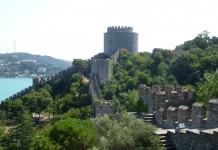
Mosaics, which are created from either glass, stone or shards of pottery, represent some of the earliest forms of human art from the Roman world. They have been found all across the remnants of the Roman Empire, both Western and Eastern, with some of the most famous mosaics being excavated in Ravenna, Italy, Turkey, and Jerusalem. The exhibition The Mosaics of Ravenna, currently being held at the Istanbul Archaeology Museums in Gülhane, highlights one set of mosaics in particular, those of Ravenna, by displaying a series of modern reproductions.
The Istanbul Archaeological Museums is a large complex of buildings and galleries located near Gülhane Park. In my opinion, it contains the most exhaustive collection of artifacts in Turkey. For those that love history, art, and culture, it’s an essential place to view the civilizations that have shaped Anatolia and the Near East.
The reproductions of the mosaics of Ravenna were carried out by artists working at the Fine Arts Academy in Ravenna during the early 20th century. The mosaics that are featured depict life during the Roman Empire. Some feature scenes from the Bible, while others show the portraits of members of the Roman/Byzantine royal family, including Emperor Justinian. One of the most striking and detailed pieces is entitled, “Judas’ Kiss”, which shows the famous scene of Judas betraying Jesus with a kiss, while the rest of the apostles look on. Even though it was difficult to portray a great deal of emotion in mosaics of this period, one gets a sense of the tragedy of the event in the facial expressions of the members of the crowd.
One of the most memorable mosaics depicts the Roman Emperor Justinian, who is responsible for commissioning the construction of the Aya Sofya Cathedral in the 6th century. “The Portrait of Justinian” shows an intensity in his eyes; one gets the sense of his power from the menacing look on his face. He comes across as a man completely in power of his empire and confident in his abilities.
Another impressive mosaic is “Theodora’s Procession with Retinue”. The Theodora referred to in this work is Roman Empress Theodora. A tremendous amount of detail is shown in this immense work. Ten people are depicted, seven in the foreground, and three in the background. What is most amazing is the significant amount of color and detail that went into depicting the variety and design of their clothes.
The rest of the mosaic reproductions on display show a variety of crowd scenes as well as portraits of important individuals of the area. Other mosaics portray ships and one intense piece of art shows an especially angry lion.
For me, one highlight of the exhibition is that it contains aerial as well as internal and external images of the Ravenna churches listed in the exhibition. In addition to this, the curators have provided detailed interior designs and plans of the aforementioned churches so that visitors can get a sense of where the original mosaics are placed and their relationship to space within the religious structures of Ravenna.
Concurrently, together with the exhibition of Ravenna mosaic reproductions, there is a small exhibition of modern mosaic art created by contemporary artists. These artists take a creative and unique perspective on mosaic art; their mosaics feature a wide range of topics, from a picnic scene to a peacock, from a red chili pepper to a reproduction of the Silence of the Lambs film poster entitled “Silence”. Out of these contemporary mosaics, one of my favorites was “Istanbul” by Polish artist Matylda Tracewska. It shows a classic view of the Istanbul coast in various shades of gray and with a small fishing boat in the foreground, done in silhouette. By combining these modern interpretations of an ancient form of art with the Ravenna reproductions, the curators show the realm of artistic possibilities that still exist with glass.
The Mosaics of Ravenna which is sponsored by the Turkish Ministry of Culture, the City of Ravenna, the Embassy of Italy in Turkey, and the Italian Institute of Culture in Istanbul, is located at the Istanbul Archaeological Museums and runs through the end of January. If you enjoy classical mosaic art, as well as new perspectives using this important art form, don’t miss this exhibition.
The Mosaics of Ravenna
16 November 2013 – 31 January 2014
Istanbul Archaeological Museums
Alemdar Cad.
Osman Hamdi Bey Yokuşu Sk.
Gülhane
Open Tuesday-Sunday, 9:00-5:00 pm
Closed Mondays
Entrance fee: 10 TL, Free with MüzeKart
Kosta Dalageorgas is a contributor to Yabangee.
[geo_mashup_map]










